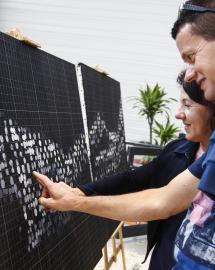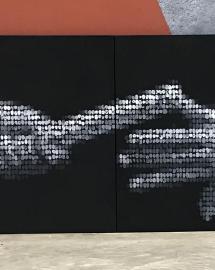The work of Olivier Terral "Devoir de mémoire": memory transmission through centuries
"Future generations have the duty to transmit the memory of radioactive waste" (Olivier Terral, painter)
As part of its program "Memory for future generations", Andra is constantly thinking about the transmission of the memory of its disposal facilities. Among the options studied: art. A somewhat philosophical Meeting with the artist Olivier Terral, whose work "Devoir de mémoire" was conceived in collaboration with the population living near the Andra facility in Meuse / Haute-Marne. An invitation to wonder about the footprint that everyone wants to leave of his passage on earth ...
The memory transmission answers a major challenge: to resist time. A problem that requires thinking about how we could communicate in many hundreds, even thousands of years, with our future descendants. Not easy. Nevertheless ... Didn't the first human beings leave traces of their passage by painting caves? Jerusalem, Alexandria, Athens, Rome, Byzantium ... doesn't the legacy of all these great civilizations continue today thanks to art in all its forms: poems, architecture, painting? Art is an authentic vector of memory throughout the centuries.
With this conviction, Andra launched in 2015, the call for projects "Art and Memory". Objective: to encourage artists to imagine works capable of conserving and transmitting the memory of radioactive waste storage sites for millennia. Among the artists who responded to this call for projects, Olivier Terral, specialist in relational painting and finger painting, caught the attention. For 2 years, in collaboration with the local residents participating in the memory group, Andra and the semiotician Florian Blanquer, he invited the visitors of the underground laboratory of the Andra Center in Meuse / Haute-Marne, and later of the Festival of Culture " RenaissanceS "in Bar-le-Duc to leavet their fingerprints as part of a dedicated work: " Duty of memory ". He comments this approach.
Andra: Could you introduce us to the concept of your work: how does it respond to the problem of memory?
Olivier Terral: It started on the 15th of October 2017 at the Science Fair and ended on the 13th of March 2019. My idea was to create a painting using fingerprints to draw a parallel between the imprint of the finger and the one we will leave with this radioactive waste. That's why I called it "Duty of Memory". The duty for future generations to transmit the memory of this waste. In total, nearly 3,000 prints were left on a blackboard with 13 levels of gray to reveal an image: a relay passage between two hands.

A: A: Why did the memory group call on you?
Olivier Terral: I proposed a concrete project, easily achievable and accessible to the general public. The group memory also appreciated the notion of community. The link between all my work is to make people active in the face of an event: the disease, an attack, and in this case, a collective responsibility. And for that, art is a great way to educate the general public and raise awareness. It does not seem like anything, but to put one's footprint is symbolically very strong. It's a commitment, a bond. Most people realize that there will remain something of their footprint. Once exposed, they realize that this painting that will survive us is also a relationship between life and death. And if you want to give meaning to your life, it also means thinking about the trace you want to leave and radioactive waste is part of this reflection.
A: What do you remember from this project? What follow-up can we give him?
Olivier Terral: It allowed me to question myself about how to preserve the story of the painting. In 100,000 years, everyone will have forgotten how it was done. So we wrote a message at the back of the table: "2017 - Notice to future generations: these footprints, a reflection of our current choices on radioactive waste management are your legacy and will impact your future decisions. These marks are milestones in time, hoping that this memory never dies. We invite you to reflect on your role in this transmission and complete this work with your present knowledge. It is an invitation for future generations to continue this picture but with the idea of marking something else and being a stakeholder in the storage of waste.


